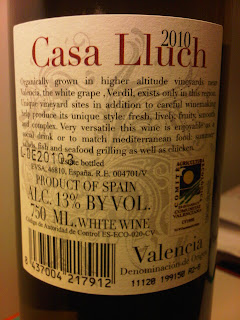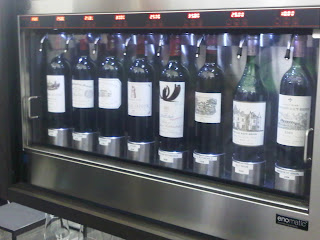We'd love to know more about what great composers from the past enjoyed drinking. Beethoven, (whose father was a singer and something of an alcoholic) used to drink in the evenings with friends at the “Zum Weissen Schwann” in Vienna. One of these was the amateur ‘cellist Nikolaus Zmeskall who used to work at the Hungarian Chancellery. In a note to him Beethoven wrote "Let us meet at seven this evening at the Schwan and drink more of their disgusting red wine." Apparently this was rough and intoxicating and was made from grapes grown locally on the foothills of the Kahlenberg at the eastern end of the Vienna Woods. It is difficult to say what this wine was. These days only international varieties (Pinot Noir, Cabernet Sauvignon) and recent crossings such as Blauer Zweigelt, Blauburger and St. Laurent are grown there.
By accident, Schubert once found himself in the castle of Wildbach and was recorded as having very much enjoyed drinking the Schilcher (rose) from Blauer Wildbacher grapes; a wine still very much appreciated and even available in the UK:
"After the weekend, Schubert and Jenger, in the company of Anselm Huettenbrenner and the Pachlers, made a three-day visit to the castle of Wildbach some twenty miles south-west of Graz, which was managed by an aunt of Dr. Pachler, Anna Massegg. Again they made music, assisted by Massegg's eldest daughter, in a beautiful 'blue room' with fine views across the garden; and they were refreshed by generous supplies of the excellent local wine, the Schilcher, a light rose which proved a particular favourite with Schubert."
Franz Schubert, A Biography, by Elizabeth Norman McKay (p.284). Oxford University Press, 1996
The date of Schubert's visit to Wildbach was September 1827.
Schubert's favorite apart from this Schilcher came from the red Kadarka grape, "The Nectar of Szekszárd," There is a legend that it inspired him to write the Trout Quintet. Legends abound concerning Hungarian wine so we should be cautious here.
Not surprisingly, Rossini's 'Gastronomia' is better chronicled but amazingly, he seems to have had a great love of Madeira which he always drank with his Maccheroni. Bizarrely he drank Bordeaux with is fish fillets and Rhine wine with his Turkey.

Rossini knew a thing or two about food so we rushed out and bought a bottle of Madeira Sercial on the assumption that it was the driest kind of Madeira he would have chosen. This example from Barbeito is certainly delicious on its own, as an aperitif. We will certainly try a thimble or three the next time we make Maccheroni (it weighs in at 19%).
Wagner developed a liking for the wines of St. Peray and once ordered 100 bottles to be sent to him in Bayreuth. 100, not 96 or 108.
When Verdi embarked for St. Petersburg in order to present “La forza del destino” at the Mariinsky Opera he brought with him Bordeaux and Champagne rather than the wines of his part of Italy, Emilia Romagna. Wine features in various Verdi operas by the way including Macbeth, La Traviata, Otello and of course Falstaff where there is a famous scene when Falstaff orders ‘una bicchiere di vin caldo” after being fished out of the Thames. It is not always remembered that this wine is later described as being ‘dolce’ – so probably warmed up sweet white wine rather than mulled red or something.
Brahms and Liszt were most famous as cigar smokers: an admirer of Liszt’s even wore one of his cigar buts on the end of a chain in her cleavage. Wine and cognac were Liszt’s other companions throughout his life. Like Schubert, he was also a devotee of Szekszárd wines. The Szekszárd Mass was composed in honour of the region, and Liszt also sent Pope Pius IX Szekszárd red as a personal gift. In old age his doctor told him to drink only Tokaj and water. His other vice was of course Wagner.
A wine connoisseur invited Brahms to dinner and in his honour brought out some of his choicest bottles. "This is the Brahms of my cellar," he announced to the company. After taking a sip, Brahms muttered, "Better bring out your Beethoven." There is a South African wine producer called Brahms.
Among contemporary composers Stockhausen would drink German wine at home. He described himself as a ‘German Composer’. He was eclectic enough though to like any wine that was good including for example a Chateau Marquis de Terme. Henze lives in Marino near Rome and drinks as the Italians do; mainly local wine as a staple but not averse to something altogether more exalted. Pierre Boulez doesn’t drink wine any more but when he did, he was not exceptionally concerned with its provenance and always drank in moderation. So much for "Lunchtime O’Boulez."
Opera singers are more noted for their use of wine in staving off symptoms than in any interest in wine per se. Red wine is either supposed to help or hinder in the case of a dry throat. It depends on whether you believe the great Russian tenor Vladimir Atlantov who says it helps or practically everyone else who warns against it. Eating raw onions is also said to be of assistance in certain cases, so much for that.
So musicians are not so different from the rest of us. Indeed they may be rather more conservative, not having the time to make a passion all-consuming. To show how little time the more obsessive of musicians have to spend on anything but music, here’s a story concerning Stravinsky who returned to Russia in the 1960s for the first time since the revolution having disapproved thoroughly of the Soviet Union.
He was dogged by a Soviet journalist who kept on bothering him for an interview. Finally he gave in. The first question was “Do you have any hobbies?” Stravinsky was nonplussed. “Hobbies? I am a composer. That is my hobby!” The journalist couldn’t let it drop. “But surely you have other interests apart from composition?” Stravinsky. “All right, I am interested in Ornitholigy”. “Ornithology – how fascinating. What is your favourite bird?” Stravinsky: “The Double-Headed Eagle.”
Stravinsky incidentally drank Ballantine's 30 year old Scotch in large quantities never leaving home without a bottle or flask full. It has been described as 'exquisite and expensive.'
 It's not as if we hadn't been to Genova before but thanks to our insider-guide we penetrated the mediaeval city - Europe's largest - for the first time. Here we encountered, also for the first time the magnificent Duomo S. Lorenzo (above) and the Chiesa Gesu with its two massive Rubens paintings. All this is testament to Genova's historical importance which placed it on a level with the greatest cities in the world; a claim not finally relinquished even today with a surviving shipbuilding and refitting industry outstripping anything in the UK.
It's not as if we hadn't been to Genova before but thanks to our insider-guide we penetrated the mediaeval city - Europe's largest - for the first time. Here we encountered, also for the first time the magnificent Duomo S. Lorenzo (above) and the Chiesa Gesu with its two massive Rubens paintings. All this is testament to Genova's historical importance which placed it on a level with the greatest cities in the world; a claim not finally relinquished even today with a surviving shipbuilding and refitting industry outstripping anything in the UK.
 (for which Berlusconi had subsequently to apologize apparently) and excellent gastronomic opportunities.
(for which Berlusconi had subsequently to apologize apparently) and excellent gastronomic opportunities.
 just a stone's throw from S. Lorenzo. Despite being in a cellar this is a warm and welcoming place where you can spend time browsing books
just a stone's throw from S. Lorenzo. Despite being in a cellar this is a warm and welcoming place where you can spend time browsing books as well as eating and drinking. We ploughed through the white wines by the glass with pleasure even if in doing so we discovered that Pigato is only a synonym for Vermentino (another variety hits the dust). Nonetheless the Pigato/Vermentinos were outstanding as were once again an Incrocio Manzoni and a Satrico which e were led to believe was a grape variety but is actually a blend from Lazio of some very familiar customers.
as well as eating and drinking. We ploughed through the white wines by the glass with pleasure even if in doing so we discovered that Pigato is only a synonym for Vermentino (another variety hits the dust). Nonetheless the Pigato/Vermentinos were outstanding as were once again an Incrocio Manzoni and a Satrico which e were led to believe was a grape variety but is actually a blend from Lazio of some very familiar customers. The following morning after a visit to the council chamber where the famous scene in 'Simon Boccanegra' takes place and a whip around a Van Gogh and Gaughin exhibition in the same building we just had time for an even shorter tour of the Mercato Orientale, one of the finest food markets in Italy.
The following morning after a visit to the council chamber where the famous scene in 'Simon Boccanegra' takes place and a whip around a Van Gogh and Gaughin exhibition in the same building we just had time for an even shorter tour of the Mercato Orientale, one of the finest food markets in Italy. Earlier in our lightening visit, we had enjoyed a glass of Rossese which is indeed a native variety of Liguria.
Earlier in our lightening visit, we had enjoyed a glass of Rossese which is indeed a native variety of Liguria. A lovely refreshing and fruity wine in the direction of Gamay/Beaujolais. We intended to buy a bottle at the airport. There was indeed one on offer but only in the collection of Ligurian speciality foods at an unbelievable rip-off price of over E.17. In fact the Duty Fee shop at Cristoforo Colombo airport it otherwise rather good. We found a Malvasia Nera there as well as a sparkling Riesling Italico (Welschriesling) from Oltrepo Pavese (rather good) and a nice sparkling Bonarda from the same area - all reasonably priced.
A lovely refreshing and fruity wine in the direction of Gamay/Beaujolais. We intended to buy a bottle at the airport. There was indeed one on offer but only in the collection of Ligurian speciality foods at an unbelievable rip-off price of over E.17. In fact the Duty Fee shop at Cristoforo Colombo airport it otherwise rather good. We found a Malvasia Nera there as well as a sparkling Riesling Italico (Welschriesling) from Oltrepo Pavese (rather good) and a nice sparkling Bonarda from the same area - all reasonably priced.



































